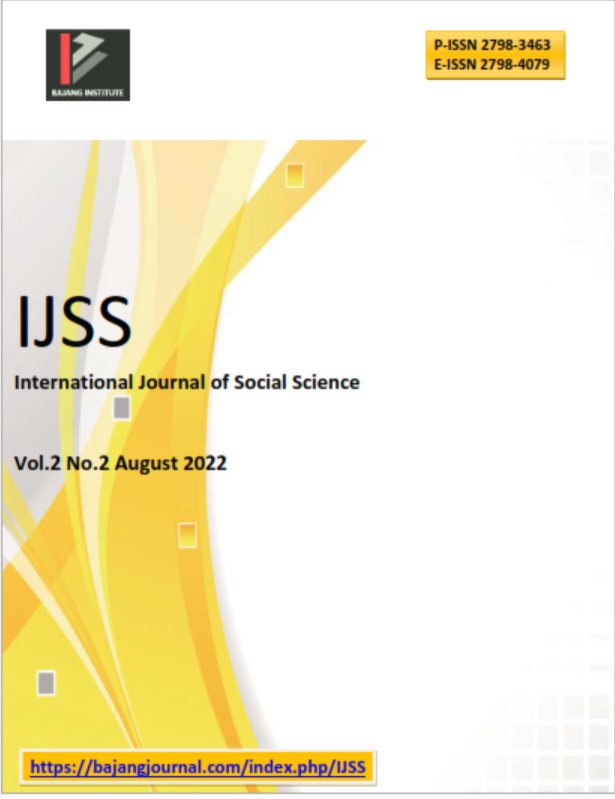CRIMINAL LAW POLICY IN THE SETTLEMENT OF TRAFFIC ACCIDENTS OF DEATH VICTIMS IN MUARO JAMBI REGENCY
DOI:
https://doi.org/10.53625/ijss.v2i2.3082Keywords:
Criminal Law Policy Effectiveness Accident TrafficAbstract
Traffic accidents often cause motorists and road users to suffer minor injuries or death. Based on the law, traffic violation cases should be resolved through legal channels. In reality, there is peace against traffic violations at the police level. This study is intended to determine the cause of the police allowing the peace of highway traffic crimes, to find out the peace made by the perpetrators of accidents related to victims of road traffic crimes. The research method used is normative research methods and empirical research methods. The data used are secondary data including primary legal materials, secondary legal materials, and tertiary legal materials, which were obtained through field research. To complete the data, it is used. field research by interviewing respondents and informants. The data that has been collected, analyzed and processed using a qualitative approach. There have been several cases of violations, including 6192 cases of motorcycles, 1532 cases of trucks, and St. Wagon 882 cases, pick up 393 cases, bus 350 cases and sedan 55 cases. The increase in the number of accidents was also followed by an increase in the percentage of victims who died due to traffic accidents. In handling it, there are obstacles, both internal and external.
References
Muladi and B. N Arief., “Bunga Rampai Hukum Pidana (Anthology of Criminal Law)”, Bandung, Alumni, 1992.
The Indonesian National Police, “Sosialisasi Undang-Undang No.22 Tahun 2009 Tentang Lalu Lintas dan Angkutan Jalan (Socialization of Law No.22 of 2009 concerning Road Traffic and Transportation)”, access at http://www.polri.go.id, April 21, 2020.
Bantuan Hukum, “Implementasi Undang-Undang Nomor 22 Tahun 2009 (Implementation of Law Number 22 Year 2009)”, access at http://bantuanhukum.or.id/implementasi-undang-undang-nomor-22-tahun-2009-tentang lalu-lintas-dan-angkutan-jalan-raya, June 26, 2020.
Laws of the republic Indonesia, “Undang-Undang No. 14 Tahun 1992 tentang Lalu Lintas dan Angkutan Jalan pasal 2 dan 3 (Law No. 14 of 1992 concerning Road Traffic and Transportation Articles 2 and 3)”. [5] Laws of the Republic Indonesia, “Undang-Undang No. 22 Tahun 2009 tentang lalu lintas dan angkutan jalan (Law No. 22 of 2009 concerning Road Traffic and Transportation)”.
W. Projodikoro, “Tindak-Tindak Pidana Tertentu di Indonesia (Certain Crimes in Indonesia)”, Bandung, Refika Aditama, 2003, p. 81.
Markas Besar Kepolisian Negara Republik Indonesia Akademi Kepolisian, “Fungsi Teknis Lalu Lintas (Traffic Technical Function)”, Semarang, Kompetensi Utama, 2009, p. 6.
Laws of the Republic Indonesia, “Undang-Undang No. 22 Tahun 2009 tentang lalu lintas dan angkutan jalan Pasal 310 (Law No. 22 of 2009 concerning Road Traffic and Transportation Article 310)”. [9] P. Rahardi, “Hukum Kepolisian: Profesionalisme dan Reformasi Polri (Police Law: Police Professionalism and Reform)”, Surabaya: Laksbang Mediatama, 2007, p. 98.
Al-Qur'an, Surat al-Maidah, verse 32.
S. Soekanto, “Pengantar Penelitian Hukum (Introduction to Legal Research)”, Jakarta, Universitas Indonesia, 2007, p. 9.
Laws of the Republic Indonesia, “Penjelasan Undang-Undang No. 22 Tahun 2009 tentang lalu lintas dan angkutan jalan (Explanation about Law No. 22 of 2009 concerning Road Traffic and Transportation)”. [13] S. Soekanto, “Polisi dan Lalu Lintas:Analisa Menurut Sosiologi Hukum (Police and Traffic: Analysis According to Sociology of Law)”, Mandar Maju, 1986, p. 27.
ARI Doi, “Tindak Pidana dalam Syariah Islam (Criminal offenses in Islamic sharia)”, Jakarta, Rineka Cipta, 1992, p. 19.
MA Suma, et al., “Pidana Islam di Indonesia Peluang, Prospek, dan Tantangan (Islamic criminal in Indonesia: opportunities, prospects, and challenges)”, Jakarta: Pustaka Firdaus, 2001, p. 88.
Constitution of Indonesia, “Undang-Undang Dasar 1945 pasal 27 ayat (1) (Constitution of Indonesia, Article 27 Verse 1”.
P. Sangaradasse and S. Eswari, “Importance of traffic and transportation plan in the context of land use planning for cities–a review”, International journal of applied engineering research, vol. 14 no. 9, pp. 2275-2281, 2019. [18] S. Soekanto, “suatu tinjauan sosiologi hukum terhadap masalah-masalah social (A review of the sociology of law on social problems)”, Bandung , Alumni, 1982), p. 51-53
R. Mammadov, “The importance of transportation in tourism sector”, In 7th Silk Road International Conference, Challenges and opportunities of sustainable economic development in Eurasian countries, pp. 381-386, May 2012.
Adorno, et al, “Ageing in a low-density urban city: Transportation mobility as a social equity issue”, Ageing & Society, vol. 38, no.2, pp. 296-320, 2018.
R. Oktorini, and LS Barus, “Integration of Public Transportation in Smart Transportation System (Smart Transportation System) in Jakarta”, Konfrontasi: Jurnal Kultural, Ekonomi Dan Perubahan Sosial, vol. 9, no.2, pp. 341-347, 2022.
L. Sieber, et al., “Improved public transportation in rural areas with self-driving cars: A study on the operation of Swiss train lines”, Transportation research part A: policy and practice, vol. 134, pp. 35-51, 2020. [23] B. Amberg, “Robust efficiency in urban public transportation: Minimizing delay propagation in cost-efficient bus and driver schedules”, Transportation Science, vol. 53, no.1, pp. 89-112, 2019.
MM Rohani, et al., “Bus operation, quality service and the role of bus provider and driver”, Procedia Engineering, vol. 53, pp. 167-178, 2013.
L. Dorn, et al., “Development and validation of a self-report measure of bus driver behaviour”, Ergonomics, vol. 53, no. 12, pp. 1420-1433, 2010.
T. B Joewono, et al., “A longitudinal analysis of traffic-violation behaviours among two groups of motorcyclist in bandung, Indonesia”, Journal of the Society of Automotive Engineers Malaysia, vol. 3, no. 2, 2019. [27] TB Ambo, et al., “Investigating influence factors of traffic violation using multinomial logit method”, International journal of injury control and safety promotion, vol. 28, no. 1, pp. 78-85, 2020. [28] HP Wiratraman, “The Challenges of Teaching Comparative Law and Socio-Legal Studies at Indonesia's Law Schools”, Asian Journal of Comparative Law, vol. 14, no. S1, pp. S229-S244, 2019.
YP Sarry, “Upaya Polisi Lalu Lintas dalam Meningkatkan Kedisiplinan Berlalu Lintas Pengendara Bermotor (Studi Deskriptif terhadap Program Kanalisasi Lajur Kiri pada Satlantas Polrestabes Surabaya)”, Kajian Moral dan Kewarganegaraan, vol. 2, no. 2, pp. 564-578, 2014.
G. Apandi and AW Asmorojati, “Peranan Polisi Lalu Lintas dalam Meningkatkan Kedisiplinan Berlalu Lintas Pengguna Kendaraan Bermotor di Wilayah Kepolisian Resort Bantul”, Jurnal Citizenship, vol. 4, no. 1, pp. 53- 67. 2014

















